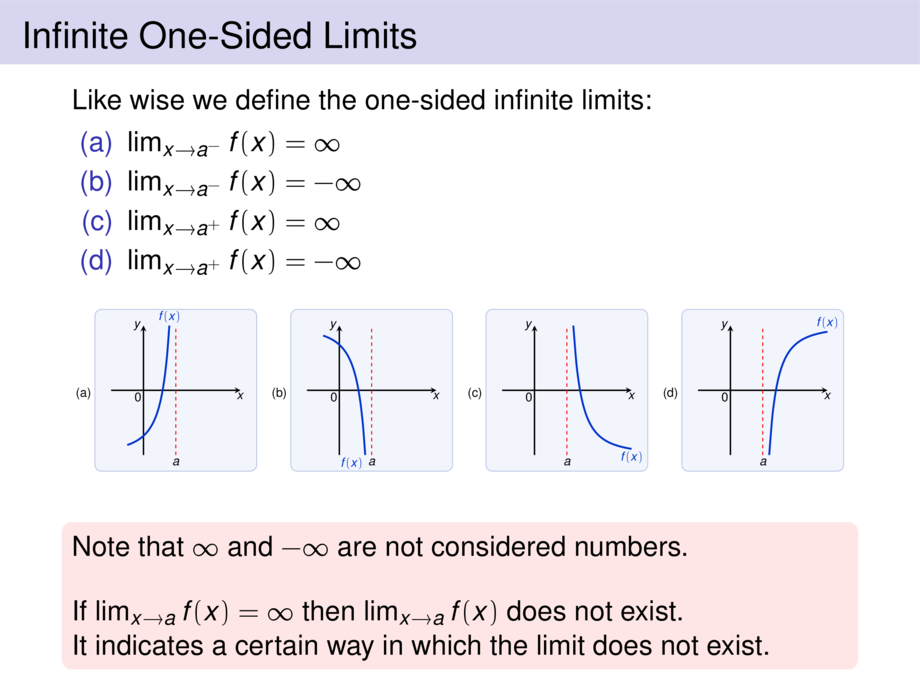



































































































126/154
\begin{frame}
\frametitle{Infinite One-Sided Limits}
Like wise we define the one-sided infinite limits:
\begin{itemize}
\item[(a)] $\lim_{x \to a^-} f(x) = \infty$
\item[(b)] $\lim_{x \to a^-} f(x) = -\infty$
\item[(c)] $\lim_{x \to a^+} f(x) = \infty$
\item[(d)] $\lim_{x \to a^+} f(x) = -\infty$
\end{itemize}
\begin{center}
\scalebox{.45}{
(a)
\begin{tikzpicture}[default,baseline=-1ex]
\diagram{-1}{3}{-2}{2}{0}
\diagramannotatez
\draw[cblue,ultra thick] plot[smooth,domain=-.5:0.8,samples=20] function{(1/((x-1.3)**2)) -2} node [above] {$f(x)$};
\node [anchor=north,inner sep=1mm] at (1cm,-2cm) {$a$};
\draw [dashed,cred] (1cm,-2cm) -- (1cm,2cm);
\end{tikzpicture}
}
\scalebox{.45}{
(b)
\begin{tikzpicture}[default,baseline=-1ex]
\diagram{-1}{3}{-2}{2}{0}
\diagramannotatez
\draw[cblue,ultra thick] plot[smooth,domain=-.5:0.8,samples=20] function{-(1/((x-1.3)**2)) +2} node [below left] {$f(x)$};
\node [anchor=north,inner sep=1mm] at (1cm,-2cm) {$a$};
\draw [dashed,cred] (1cm,-2cm) -- (1cm,2cm);
\end{tikzpicture}
}
\scalebox{.45}{
(c)
\begin{tikzpicture}[default,baseline=-1ex]
\diagram{-1}{3}{-2}{2}{0}
\diagramannotatez
\draw[cblue,ultra thick] plot[smooth,domain=1.2:3,samples=20] function{(1/((x-0.7)**2)) -2} node [below] {$f(x)$};
\node [anchor=north,inner sep=1mm] at (1cm,-2cm) {$a$};
\draw [dashed,cred] (1cm,-2cm) -- (1cm,2cm);
\end{tikzpicture}
}
\scalebox{.45}{
(d)
\begin{tikzpicture}[default,baseline=-1ex]
\diagram{-1}{3}{-2}{2}{0}
\diagramannotatez
\draw[cblue,ultra thick] plot[smooth,domain=1.2:3,samples=20] function{-(1/((x-0.7)**2)) +2} node [above] {$f(x)$};
\node [anchor=north,inner sep=1mm] at (1cm,-2cm) {$a$};
\draw [dashed,cred] (1cm,-2cm) -- (1cm,2cm);
\end{tikzpicture}
}
\end{center}
\pause
\begin{alertblock}{}
Note that $\infty$ and $-\infty$ are not considered numbers.
\bigskip\pause
If $\lim_{x \to a} f(x) = \infty$ then $\lim_{x \to a} f(x)$ does not exist.\\
It indicates a certain way in which the limit does not exist.
\end{alertblock}
% \begin{block}{Infinite Left-Limit}
% \alert{$\lim_{x \to a^-} f(x) = \infty$}
% if we can make the values of $f(x)$ arbitrarily large
% by taking $x$ sufficiently close to $a$ with \alert{$x < a$}.
% \end{block}
%
% \begin{block}{Infinite Right-Limit}
% \alert{$\lim_{x \to a^+} f(x) = \infty$}
% if we can make the values of $f(x)$ arbitrarily large
% by taking $x$ sufficiently close to $a$ with \alert{$x > a$}.
% \end{block}
%
% \begin{block}{Negative Infinite Left-Limit}
% \alert{$\lim_{x \to a^-} f(x) = -\infty$}
% if we can make the values of $f(x)$ arbitrarily large \alert{negative}
% by taking $x$ sufficiently close to $a$ with \alert{$x < a$}.
% \end{block}
%
% \begin{block}{Negative Infinite Right-Limit}
% \alert{$\lim_{x \to a^+} f(x) = -\infty$}
% if we can make the values of $f(x)$ arbitrarily large \alert{negative}
% by taking $x$ sufficiently close to $a$ with \alert{$x > a$}.
% \end{block}
\end{frame}

